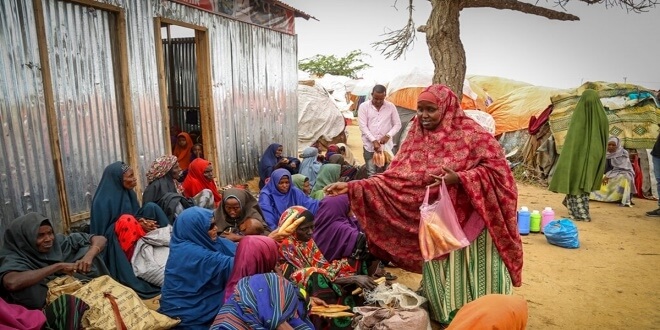
Our Projects are
Transforming African Trade
Quick Contacts
2nd Floor, Fidelity Insurance Centre Waiyaki Way, Westlands

The United Nations Office for the Coordination of Humanitarian Affairs, OCHA, said that during the month of July another 83,000 people were forced to flee their homes because of the drought, with the worst displacement coming in the Bay, Banadir and Gedo regions.
Ishaku Mshelia, deputy emergency coordinator for the U.N. Food and Agriculture Organisation, told VOA via telephone Wednesday that people are migrating in search of food and other assistance.
He said the FAO is trying to help.
“Our ability as [a] humanitarian community is to be able to reach the affected people in their communities and provide the services that they need so that they … don’t feel pushed to migrate,” Mshelia said. “Unfortunately, previous droughts, what we have seen is that a lot of mortalities have been reported where people that, unfortunately, died on their way to open areas in search of assistance.”
FAO Somalia said it needs $130 million to fully fund its famine prevention plan, designed to help about a million people in rural areas.
A statement issued by the FAO on Wednesday said that if the funding gap is not addressed, widespread famine may be inevitable.
Drought-related malnutrition has killed 500 children, according to the U.N. Children’s Fund, UNICEF.
Authorities in Somalia’s Gedo region also confirmed to VOA more than 50 deaths of children due to suspected drought-related illnesses. The deaths were reported in the towns of Bardere and Beledhawo, which border Kenya.
Ali Yusuf Abdullahi, the Gedo regional administration spokesman, said that the region is witnessing a “catastrophic” situation due to drought.
He said that people are fleeing in search of a better life and have gathered in major towns including Dolow, near the Ethiopian border.
As of today, Abdullahi said, Dolow has received more than 50,000 displaced people and there are people who are coming from the Ethiopian side who were affected by the drought there and settling in IDP camps in Dolow. He said the town administrators are doing their best to provide relief, but that is not enough.
Somalia’s federal government declared the three-year drought a national emergency last year. The drought, Somalia’s worst in more than 40 years, has affected more than 7 million people.
According to the Somali prime minister’s office, the drought has also killed more than two million livestock.
Meanwhile, Uganda’s President Museveni has pledged to support Somalia in its bid to join the East African Community (EAC) and exploit trade opportunities that exist in the region.
Museveni said Somalia has all qualifications to join EAC, which include; sharing a border with one of the member countries, having a private sector-led economy, and being a democratic country.
He was speaking during the closing ceremony of a two-day inaugural Uganda-Somalia business and investment summit held in Kampala yesterday.
The summit attended by Somalia President Hassan Sheik Mohamud, among other dignitaries, aimed at providing a platform for the private sector, the business community, and the government to discuss ways of reducing the cost of doing business between the two countries.
ECA currently comprises Uganda, Kenya, Tanzania, Rwanda, Burundi, South Sudan, and DR Congo. Abdirashid Duale, the chief executive officer of Dahabshiil, a money transfer company, said the summit not only presents opportunities but also helps the business community understand the challenges that people in the region face.
Duale said while Dahabshiil operates in Uganda, there are more opportunities for the company to expand due to a conducive investment environment.
Other companies, including Somtel, one of Somalia’s largest telecom companies, exhibited their products and services at the summit.
According to SomInvest, an investment promotional agency in the horn of Africa, Somalia is striving to attract investors in renewable energy and expand on its power generation capacity.
Renewable energy is a viable and immediate way to increase affordable energy, according to the African Development Bank (ADB).
Somalia has one of the highest potentials for onshore wind power in Africa and one of the highest rates of daily total solar radiation in the world.
Amina Hersi, a Kampala-based woman of Somali origin, who runs a number of businesses in Uganda, including Atiak Sugar Factory, said EAC provides a huge market that all member states should exploit.
On Tuesday, President Mohamud visited Luweero Industries, which is managed by the Uganda People’s Defence Forces, in Nakasongola District.
Maj Gen Sabiiti Muzeeyi, the general manager of the facility, told President Mohamud that they carry out many activities, among them the production of crop fertilizers, mineral water, explosives, breeding of cattle for beef, and manufacture of medicines.
President Mohamud said he was amazed at the diversity of areas that UPDF is engaged in and gaining tangible results. He stated that this reminds him of how useful the military is to society.
During a high-level retreat for the East African Community common market last month, Somalia expressed interest to join EAC. President Mohamud said Somalia belongs to EAC since it has been doing business with member states.
Read original article
Disclaimer: The views and opinions expressed in this article are those of the authors and do not necessarily reflect the official policy or position of TradeMark Africa.